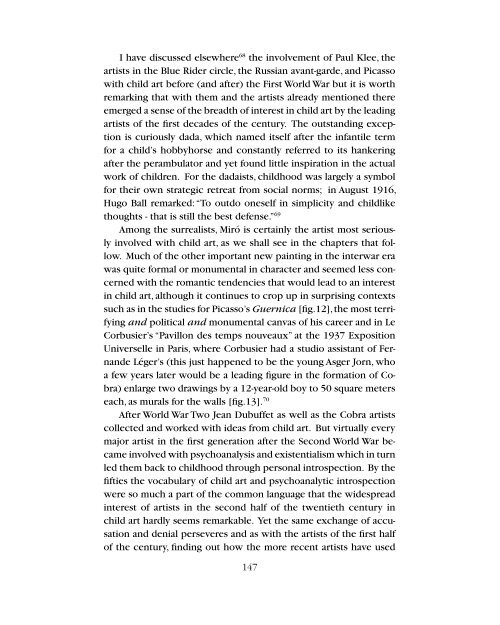Jonathan Fineberg – The Postman Did It – Children’s Art and the Avant-garde
Excerpt from “A Kid Could Do That!”, an extensive publication prepared by Galerie Gmurzynska on the occasion of the large-scale eponymous exhibition project at Art Basel Miami Beach 2014, conceived with Hollywood luminaries Baz Luhrmann and Catherine Martin.
Excerpt from “A Kid Could Do That!”, an extensive publication prepared by Galerie Gmurzynska on the occasion of the large-scale eponymous exhibition project at Art Basel Miami Beach 2014, conceived with Hollywood luminaries Baz Luhrmann and Catherine Martin.
- No tags were found...
Create successful ePaper yourself
Turn your PDF publications into a flip-book with our unique Google optimized e-Paper software.
I have discussed elsewhere 68 <strong>the</strong> involvement of Paul Klee, <strong>the</strong><br />
artists in <strong>the</strong> Blue Rider circle, <strong>the</strong> Russian avant-<strong>garde</strong>, <strong>and</strong> Picasso<br />
with child art before (<strong>and</strong> after) <strong>the</strong> First World War but it is worth<br />
remarking that with <strong>the</strong>m <strong>and</strong> <strong>the</strong> artists already mentioned <strong>the</strong>re<br />
emerged a sense of <strong>the</strong> breadth of interest in child art by <strong>the</strong> leading<br />
artists of <strong>the</strong> first decades of <strong>the</strong> century. The outst<strong>and</strong>ing exception<br />
is curiously dada, which named itself after <strong>the</strong> infantile term<br />
for a child’s hobbyhorse <strong>and</strong> constantly referred to its hankering<br />
after <strong>the</strong> perambulator <strong>and</strong> yet found little inspiration in <strong>the</strong> actual<br />
work of children. For <strong>the</strong> dadaists, childhood was largely a symbol<br />
for <strong>the</strong>ir own strategic retreat from social norms; in August 1916,<br />
Hugo Ball remarked: “To outdo oneself in simplicity <strong>and</strong> childlike<br />
thoughts - that is still <strong>the</strong> best defense.” 69<br />
Among <strong>the</strong> surrealists, Miró is certainly <strong>the</strong> artist most seriously<br />
involved with child art, as we shall see in <strong>the</strong> chapters that follow.<br />
Much of <strong>the</strong> o<strong>the</strong>r important new painting in <strong>the</strong> interwar era<br />
was quite formal or monumental in character <strong>and</strong> seemed less concerned<br />
with <strong>the</strong> romantic tendencies that would lead to an interest<br />
in child art, although it continues to crop up in surprising contexts<br />
such as in <strong>the</strong> studies for Picasso’s Guernica [fig.12], <strong>the</strong> most terrifying<br />
<strong>and</strong> political <strong>and</strong> monumental canvas of his career <strong>and</strong> in Le<br />
Corbusier’s “Pavillon des temps nouveaux” at <strong>the</strong> 1937 Exposition<br />
Universelle in Paris, where Corbusier had a studio assistant of Fern<strong>and</strong>e<br />
Léger’s (this just happened to be <strong>the</strong> young Asger Jorn, who<br />
a few years later would be a leading figure in <strong>the</strong> formation of Cobra)<br />
enlarge two drawings by a 12-year-old boy to 50 square meters<br />
each, as murals for <strong>the</strong> walls [fig.13]. 70<br />
After World War Two Jean Dubuffet as well as <strong>the</strong> Cobra artists<br />
collected <strong>and</strong> worked with ideas from child art. But virtually every<br />
major artist in <strong>the</strong> first generation after <strong>the</strong> Second World War became<br />
involved with psychoanalysis <strong>and</strong> existentialism which in turn<br />
led <strong>the</strong>m back to childhood through personal introspection. By <strong>the</strong><br />
fifties <strong>the</strong> vocabulary of child art <strong>and</strong> psychoanalytic introspection<br />
were so much a part of <strong>the</strong> common language that <strong>the</strong> widespread<br />
interest of artists in <strong>the</strong> second half of <strong>the</strong> twentieth century in<br />
child art hardly seems remarkable. Yet <strong>the</strong> same exchange of accusation<br />
<strong>and</strong> denial perseveres <strong>and</strong> as with <strong>the</strong> artists of <strong>the</strong> first half<br />
of <strong>the</strong> century, finding out how <strong>the</strong> more recent artists have used<br />
147

















